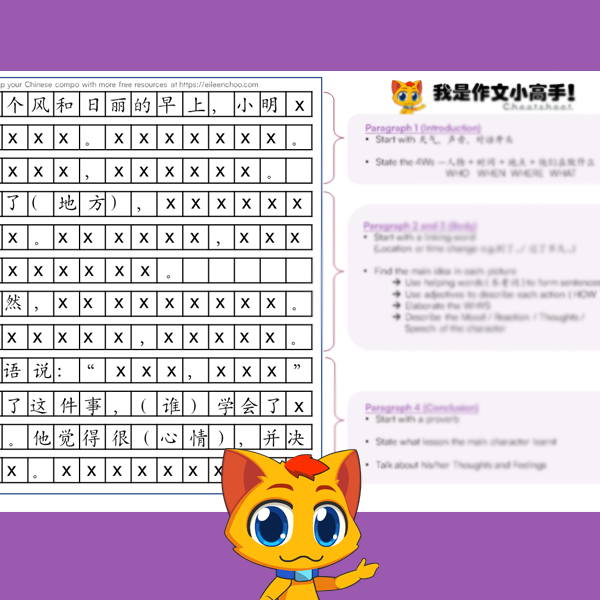Now Chinese exams can be scary, but you can reduce that fear if you know what to expect. Let’s look at what the Chinese exam paper comprises of.
What’s tested in the PSLE Chinese exam paper?
The examinable components for PSLE Chinese is similar to the English PSLE paper. They consist of 4 components – oral, listening comprehension, Chinese paper 1 (Composition writing) and paper 2 (The written exam).
To strategize which component to focus on to maximize your points, let’s study how the marks are allocated for each part.
PSLE Chinese weightage for Standard Chinese
Let’s start with the score breakdown for the most common normal standard Chinese exam.
PSLE Exam Component
Marks
Weightage
The total marks for the standard Chinese exam is 200. This total score will eventually be converted to 100% to calculate your child’s final Chinese AL score.
This is the same grading system as Primary 5.
*PSLE Chinese weightage for Foundation Chinese
If your child is taking foundation Chinese, they’ll have one less component to worry about as they would not have to write compositions. The total marks for the foundation Chinese paper will also be slightly different as it’ll be 100 instead of 200.
Here’s the score breakdown:
PSLE Exam Component
Marks
Weightage
*PSLE Chinese weightage for Higher Chinese
If your child is taking higher Chinese, they’ll only have to do 2 components – Composition and the written exam. Just like the foundation paper, the total marks for the higher Chinese paper will also be 100 instead of 200.
Here’s the score breakdown:
Now that we know what the different components are, let’s take a deeper look into each PSLE exam component to find out what’s expected.
What’s tested for Chinese oral?
The first PSLE exam component that your child will sit for is the oral examination.
During this Chinese oral exam (e-oral), they’ll need to read a Chinese passage, watch a video and hold a conversation with their examiner based on the content of the video.
What about listening comprehension?
The next exam component they will face is Chinese listening comprehension.
Your kid will need to listen to a few genres of Chinese passages. This ranges from advertisements, directions, stories etc. Then, they’ll need to answer some multiple choice questions (MCQs) based on what they have heard.
This is a bonus to most students since it’s the easiest component to score. Try to aim for a minimum of 90% accuracy if you can.
Then let’s look at Chinese paper 1…
Chinese paper 1 is also the composition writing part.
Your kid will need to choose between writing a compo that is based on a set of given outline, or write one that is based on some given pictures. More tips on that later.
Take note that dictionaries and electronic dictionaries are allowed to be used for this section. So remember to check if your kid’s physical dictionary or electronic dictionary is approved for use in the PSLE before this exam.
…and the Chinese paper 2 written exam!
The written exam in paper 2 will assess your kid’s level of Chinese vocabulary, grammar and overall mastery of the language. This takes the form of MCQs and open ended questions.
No Chinese dictionary is allowed here. Do take note that this paper is also the one that contains one of the components that most kids fear – Chinese comprehension.
Need help preparing for PSLE Chinese?
Here’s a suggested game plan according to your goals:
Whether you are looking to pass your Chinese exam or score a good grade, here’s my winning formula for my school kids that works for all abilities.
- Aim to get full marks for listening comprehension
(or at most make 1 mistake) - Get at least 40 marks for oral
- Get at least 30 marks for compo
- Pass your paper 2
18 + 40 + 30 + 45 = 133! This would translate to 66.5%, which is already more than a pass (AL5)! Then all you need to do from here is to adjust this formula according to your strengths and weaknesses so that you focus on the right areas to get the results you want.
That’s it for standard Chinese. If you are wondering how to a pass, merit or distinction in Higher Chinese, check out this post instead!
2024 PSLE dates you need to know for the Chinese papers
Now that you know exactly what to expect for the PSLE Chinese exam and how to plan for it, the last thing you’ll need to do is to mark all these important dates for the Chinese PSLE exam and get your revision plan going. All the best!
Source: MOE







